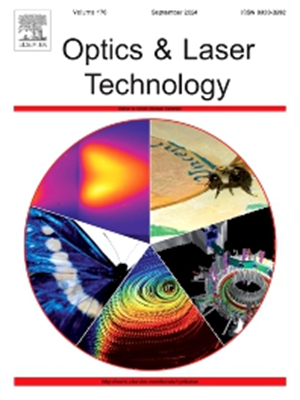利用一维激光传感器对机器人磨头三维坐标系进行降维标定
IF 5
2区 物理与天体物理
Q1 OPTICS
引用次数: 0
摘要
对在密闭空间(如整体圆盘)进行高度可接近磨削的需求,推动了使用磨头的机器人磨削和抛光的研究和应用。实现磨削头的高精度和低成本校准是一个主要挑战。为此,提出了一种新的降维标定方法。该方法采用一维点激光位移传感器对三维磨头坐标系进行标定。首先,提出了一种传感器手眼标定方法。“拟合一步旋转法”通过拟合确定旋转轴和角度,再进行一步旋转,使法兰平面与激光发射平面平行,从而完成传感器方位标定。“两步旋转法”将法兰中心与传感器测量原点对齐,完成传感器位置校准。随后,以预标定传感器为中介,对三维磨头坐标系进行标定。“两步平移法”使磨头端面与激光发射平面平行,完成磨头方位标定。“空间三点法”将磨头中心与传感器测量原点对齐,完成磨头位置标定。最后,实验表明,手眼标定精度可保持在0.178 mm和0.6°范围内,磨头标定精度可保持在0.08 mm和0.4°范围内。该标定方法精度高、成本低、稳定性可靠,同时支持编程快速标定,实现机器人磨削抛光的高精度自动化。本文章由计算机程序翻译,如有差异,请以英文原文为准。
Dimensionality reduction calibration of a robotic grinding head’s 3D coordinate system using a 1D laser sensor
The demand for highly accessible grinding in confined spaces, such as integral blisks, has driven research and applications in robotic grinding and polishing using a grinding head. Achieving high-precision and low-cost calibration of the grinding head is a primary challenge. Consequently, a novel dimensionality reduction calibration method is proposed. This method employs a 1D point laser displacement sensor to calibrate the 3D grinding head coordinate system. Firstly, a hand-eye calibration method for the sensor is proposed. The “fitting and one-step rotation method” determines the rotation axis and angle through the fitting, followed by one-step rotation to make the flange plane parallel to the laser emission plane, thereby completing the sensor orientation calibration. The “two-step rotation method” aligns the flange center with the measurement origin of the sensor to complete the sensor position calibration. Subsequently, the 3D grinding head coordinate system is calibrated with the pre-calibrated sensor as an intermediary. The “two-step translation method” makes the grinding head’s end face parallel to the laser emission plane, completing the grinding head’s orientation calibration. The “spatial three-point method” aligns the grinding head center with the sensor’s measurement origin, completing the grinding head’s position calibration. Finally, the experiments demonstrate that the precision of hand-eye calibration can be maintained within 0.178 mm and 0.6°, while the accuracy of the grinding head calibration is within 0.08 mm and 0.4°. The calibration method provides high precision, low cost, and reliable stability while supporting programming for rapid calibration, thereby facilitating the high-precision automation of robotic grinding and polishing.
求助全文
通过发布文献求助,成功后即可免费获取论文全文。
去求助
来源期刊
CiteScore
8.50
自引率
10.00%
发文量
1060
审稿时长
3.4 months
期刊介绍:
Optics & Laser Technology aims to provide a vehicle for the publication of a broad range of high quality research and review papers in those fields of scientific and engineering research appertaining to the development and application of the technology of optics and lasers. Papers describing original work in these areas are submitted to rigorous refereeing prior to acceptance for publication.
The scope of Optics & Laser Technology encompasses, but is not restricted to, the following areas:
•development in all types of lasers
•developments in optoelectronic devices and photonics
•developments in new photonics and optical concepts
•developments in conventional optics, optical instruments and components
•techniques of optical metrology, including interferometry and optical fibre sensors
•LIDAR and other non-contact optical measurement techniques, including optical methods in heat and fluid flow
•applications of lasers to materials processing, optical NDT display (including holography) and optical communication
•research and development in the field of laser safety including studies of hazards resulting from the applications of lasers (laser safety, hazards of laser fume)
•developments in optical computing and optical information processing
•developments in new optical materials
•developments in new optical characterization methods and techniques
•developments in quantum optics
•developments in light assisted micro and nanofabrication methods and techniques
•developments in nanophotonics and biophotonics
•developments in imaging processing and systems

 求助内容:
求助内容: 应助结果提醒方式:
应助结果提醒方式:


